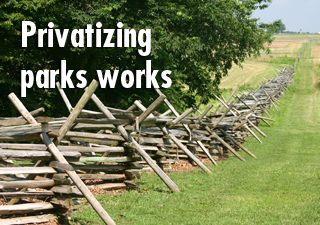Commentary

Private Parks Promote Public Preservation
It is an oft-disseminated myth that government has to be the sole guardian of our historic sites, museums, and parks. For instance, during the 2009 state budget impasse, Gov. Rendell stoked fears that, without taxpayer dollars, up to 400 state parks might be closed, and museums wouldn’t be able to survive. But the success of philanthropy and entrepreneurship in preserving our historic sites and natural resources has been overlooked.
Government has proven to be less efficient in its operation and maintenance of these treasured resources. The leading example is the National Park Service (NPS), which has an operating deficit of approximately $580 million and $9.2 billion in maintenance needs. The NPS originally was intended to be self-sufficient through user fees, but in 1918, Congress redirected the revenue collected by the parks to the treasury. The system was partially corrected in 1996, but not before the model for autonomy had been broken. Parks are not charging adequate fees-for instance, Yellowstone parking passes today sell for one-third their inflation-adjusted price in 1916. Furthermore, government park systems have been rampant with corruption and patronage; for instance, 19 NPS employees at Yosemite used tax dollars to build homes for themselves.
Parks, as well as other publicly owned and operated sites, are a burden on taxpayers, but there is a simple solution-leasing contracts and individual philanthropy. Leasing contracts are long-term, performance-based agreements for the right to operate and maintain historical sites, parks, and the like. Contracts ensure all expectations by the state are met, including a price ceiling, development restrictions, general operation requirements, and overall quality.
Some of the best historical sites in Pennsylvania are already privately owned and operated, including the Shriver House Museum and General Lee’s Headquarters Museum in Gettysburg, which are the only museums in Pennsylvania to make the History Channel’s “10 Must Visit U.S. Historical Sites.” In fact, over half of the attractions highlighted by the History Channel are either public-private partnerships or privately owned and operated.
Last year, philanthropy saved the annual re-enactment of Pennsylvania’s historic Washington’s Crossing. Boyd Theater was listed as one of America’s 11 Most Endangered Historic Places until a developer purchased and revitalized the building, turning part of it into a hotel. Nonprofit groups such as Eastern National and Bryce Canyon Natural History Association operate educational activities in national parks and have donated millions of dollars to preserving these sites.
In fact, the private sector preserved many historic sites before government took control of them. It was William Kent’s intention when he purchased acres of redwoods forest to preserve the land, and only after state threats of eminent domain did he donate his land to the federal government to establish the Muir Woods National Monument. Gettysburg Battlefield memorial was established by a nonprofit citizens group that purchased the land and successfully preserved the historic site for 30 years, until the federal government took control of the land to turn it into a national military park.
While government is struggling to run our parks, historic sites, and museums, private companies are willing to pay to operate these services.
The private sector has already achieved success in establishing and running historical and natural sites. One such company, Recreation Resource Management (RRM), has offered to lease state parks from Arizona, including six that the state was planning on closing this year. RRM has an impressive resume, already managing over 150 federal, state, and local parks. Its campgrounds are included in the nation’s top 100 family places to camp.
Privately managed sites can be more efficiently run, maintaining a high-quality service at less cost than state-controlled operations. Private companies have the incentive to create cost-effective programs that meet visitors’ needs without breaking the bank. It also prevents the abuse of taxpayers’ money through greater oversight and accountability.
Pennsylvania runs 117 state parks and 23 historic sites and museums. The state should be looking for private-sector solutions to lease and sell these sites. If historic and natural sites are valuable, they will be preserved through entrance fees, non-profit organizations, and private philanthropy, rather than ever-increasing taxpayer support.
# # #
Katrina Currie is a research fellow with the Commonwealth Foundation (CommonwealthFoundation.org), an independent, nonprofit public policy research and educational institute based in Harrisburg.